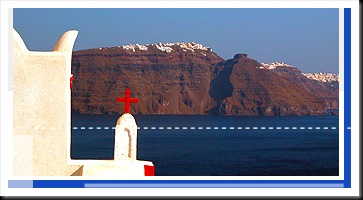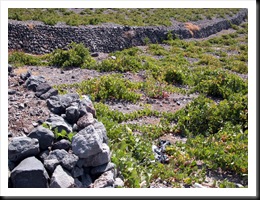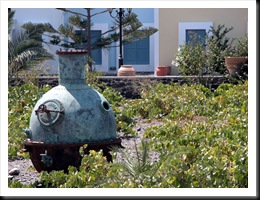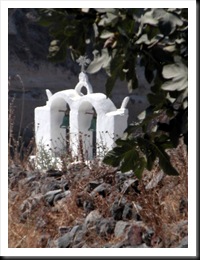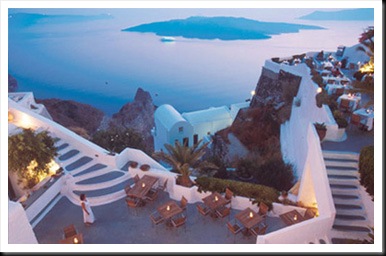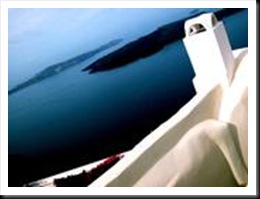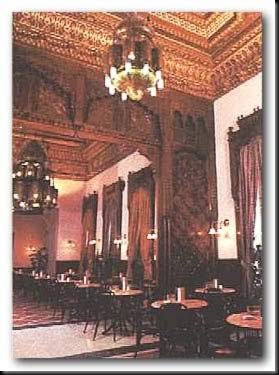It was mid 19th century, when the nightmare of vines, the Phylloxera, did "hit" the vineyards of entire Europe. The destruction was absolute, and all the vines of anile Continent died, leaving our ancestors without grapes and wines, for a lot of decades.
ALL?
NO!
A small volcanic rock, full of vines from the prehistoric years at the edge of Europe, it resisted! (sources we have from the town of Akrotiri, 16th century B.C., the so called Greek Pompey)
The American vines that were planted, the next years in France, Italy, and other wine making countries of Europe, did not come ever here, and thus therefore ladies and gentlemen, i am proud to introduce you, to the most ancient vineyard of the world!!!
At the older times the beginning of the Vendema (harvest) was a big celebration for the all island, and late night, when the harvesters returned back to the wineries (Canavas*) the party started with songs and dances, and plenty of the unique local fava, white aubergines, cheese, caper, cherry tomatoes and of course wine!
And the marvel does not stop here: Santorini, one of the most beautiful islands of the world, and one of the top 10 island world destinations, according to the readers of eminent travelling magazine "Code Nast", is a place exceptionally arid, with strong winds, and volcanic rocks rich in lava and pumice. And this precisely is that makes the wines leading in the world! And of course the people! The intelligence of local, that for centuries experiment and enjoy their goods.
They built dry stone walls (πετρολιθιές), that each winter were falling down from the winds, and each spring builting up again, in order to keep the soil. And most peculiar: People developed a technique, called "couloura". They give to the plants a shape, like basket, in which the grapes are " hiding" inside, and being protected from the strong winds. It also allows to the plants to "drink" the early morning summer fog.
Last 10 years charismatic wine makers of the island, also developed the know-how, (something that was absent from the Greek wines), in combination with the precedents traditional characteristics of vineyard, they give us certain masterpieces!
THE PEOPLE AND THE WINERIES
Exactly at the back of this sign that writes " ROOMS TOLET" in the medieval village of Pirgos, that his householders do believe that simply rent " rooms with toillet" (...), the dream for some people still continued.
There the organic vineyard of Chatzidakis, (Telephone: 22860 32552, 32466, 6973989158) produces Santorini Asyrtiko (Alc%: a 12,5) a "classico Santorini" , in an old cave house, that was changed in wine factory.
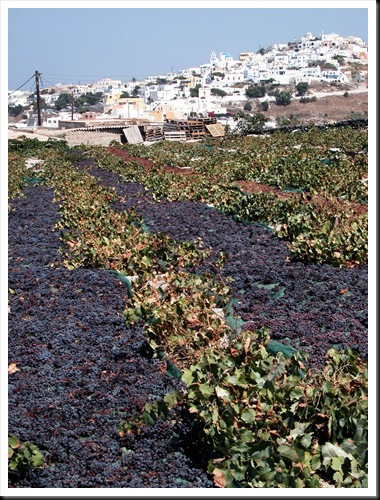 Red grapes lying under the Aegean sun, at Chatzidakis winery, prepared for the award winning "Vinsanto". Chatzidakis won the Grand Golden award, at the International Thessaloniki wine Festival in 2008. At the back the village of Pirgos.
Red grapes lying under the Aegean sun, at Chatzidakis winery, prepared for the award winning "Vinsanto". Chatzidakis won the Grand Golden award, at the International Thessaloniki wine Festival in 2008. At the back the village of Pirgos.
I might not did try the Mayrotragano, but I did try it in the winery of Paris Sigalas, in the region of Baxedes, outside Oia village.
The view?
August vineyards, harpesters with enormous hampers, and the Aegean sea at the back. We did try initially the astonishing Asyrtiko, DOMAIN SIGALAS 1996¨"
And what we mean saying Asyrtiko (A seer tee ko) in Santorini?
It is the grape that covers 80% of the plantings on the Island. It produces a wine extracted mid-palate and overt minerality. It has a unique combination of high alcohol (13% - 13.5%) with excessively high acidity. Balance is achieved with the dehydration of the grapes which not only raises potential alcohol but also dry extract which gives this wine such an incredible texture.
Is often described as Greece's best white wine grape, and this is something that i attent to believe as well.
 Mr. Aggelos from Pirgos village.
Mr. Aggelos from Pirgos village.
Finally came the day that we tried red Mayrotragano . This is a local red variety. Because of its naturall high sugar levels, was traditionally used in the production of sweet wine.
Paris Sigalas has been experimenting with the grape for many years. He started with a half to half blend of Maurotragano and another local red variety called Mandilaria. Finally he managed to make a 100% Maurotragano, and now in that beautiful restaurant called Krinaki¨ in the fairytale village of Finikia, with lots of meat and other Greek mezedes (appetizers or tapas), our mouth fills from the full body, our toqnue enjoys the almost perfect tannin structure, and the pleasant of ours was just absolut.
A wine that has an amazing aging ability. I am wondering and i can't wait… (Telephone: 22860 71644)
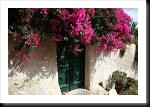 Antoni's house door, Mesa Gonia village
Antoni's house door, Mesa Gonia village
There are some lost villages on the island, and "Mesa Gonia" which was hit mostly of all from the last volcanic earthquake in 1956, has almost never been inhabited again.
In that village is the house of my friends Antonis (there are 2 of them) of Tithora rock bar, and at the entrance of the village is the traditional winery of Argyros, built in 1903. My friends told me that i can find the best Raki(*) in Santorini, but the "Vinsanto" it is just to make you cry... (tel: 22860 31489)
This is a natural sweet red wine, and is something like a trade mark of Santorini!
Quite expensive, but no reason to discuss that. It needs 6-9 kilo of grapes for just one litre of wine.
70% Asyrtiko, 20% Aidani and 10% Athiri, are the varieties (all local) .
Aromas of orange, tangerine, fig and caramel for the finish. Aged for several years, i think Argiros is the one that ages that unique desert wine, more than anybody else on the island.
For sure with this product, Argyros entered at the list of Greece's elite winemakers.
Famous Thalassitis white wine is a product of another small winery called "GAIA" (means "earth" in ancient Greek tel: 6945777814) that seems they doing something special...
Quite "strong" to taste it straight, this Asirtiko, has a great crisp finish makes it amazing for serving it with food and especially sea food!
For serious wine drinkers...
Alcohol (% vol): 13,0
I know that if you like to drink, you also like to eat..
And if GAIA is proud of their wines, for sure is proud of it's vinegar.
Award winner of the biggest Greek newspaper "Gourmet" magazine, this Asirtiko vinegar is left to age in barrels for five years, acquiring a fruity and deep flavor that is addictive.
There are almost 40 (!) native varieties. Some i did not named yet are, Voudomato, Potamia, Gaidouria, and of course the famous Nichteri, which is the traditional local house white wine.
Took it's name because of the vinification procedure at the past was during the night, in order to avoid the oxidization of this very sensitive vine.
The Canavas
Santorini is really a small island, only m73 sq.mtr, and with about 13.000 residents. 13 villages, each one of them with the old, medievial part at the centre, and with about 15 (!)wineries, or canavas. Most of them are proffesional wineries, but there are some house wineries as well.
Canavas was an integral part of every rich captain's house.
They have a specific architecture. The front part is open and small, with ussually two windows. One window faces the north and the other the south, in order to ventilated the place from exhalations.
Most of them are about 150 years old , but you can find really old Canava buildings, like even 500 years old.
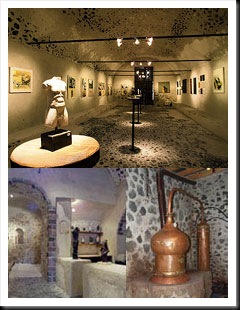 "Art Space" Canava. A winery and gallery as well! Exo Gonia village
"Art Space" Canava. A winery and gallery as well! Exo Gonia village
A Legendary Bar
It was the year 1969, when a young Italian barman called Franco, visited Santorini for the very first time.
Franco him self refer's to that visit with the following words:
"When we first visited the island in 1969, Fira the capital of the island was just a small village, with the caldera side mostly consisting of ruined buildings, after the devastating earthquake of 1956. We remember how, at the time, it was impossible to find even a good cup of coffee or a simple Campari and Soda "(haha!!!)
In 1978 returned back, decided to built a cocktail bar on the Caldera, the volcanic cliff of the island, playing only classical music.
It was then when some New Yorkers journalists, visited the island.
Sitting on the Caldera, overviewing the breathtaking volvano and Aegean sea, (when there was no other bar or restaurant at the area), tasting beautiful cocktails and listening classical music.
They need no more. Returning back home, they wrote about it in New York Times. Next year the New Yorican creme de la creme was there at "Franco's Bar" in Santorini!
In 1985 a worldwide survey undertaken by News Week International Magazine, classified Franco's, amongst "The World's Bar Best"!
A legend just began. The following years many rich and mostly famous artists, writers and actors from all over the globe visited the bar.
Franco's Bar is still here, serving cocktails, with classical music, beetween many other bars... and i really, dont give 7 euro for a freddo espresso coffee...
The world is not the same...
"Selini" restaurant, one of the oldest in Fira, continues serving Mediteranean magic.
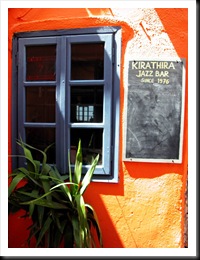 "Kira Thira Jazz Bar" . Probably the oldest bar on the island. From 1976!
"Kira Thira Jazz Bar" . Probably the oldest bar on the island. From 1976!
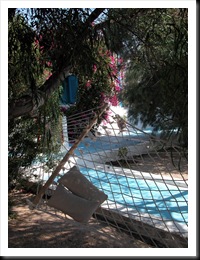 My home on the island, in front of the beach.
My home on the island, in front of the beach.
Stay in Santorini island, but not make them rich:
www.bluedolphins.gr by the caldera or,
www.glarossantorini.com in front of the beach
